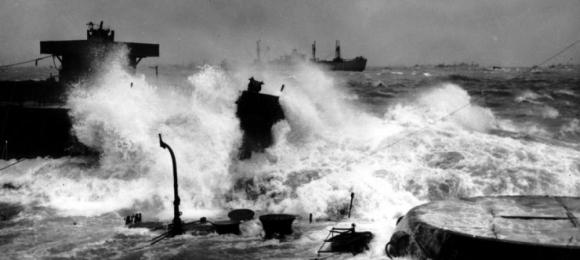
Mulberry harbor in the storm of June 19-22, 1944
Eighty years ago this week, during the early days of the Allied invasion of Europe, the sea would prove to be as formidable an enemy as the Germans. A storm, the worst in 80 years, came close to wiping out the Mulberrys — the two portable harbors built at Normandy to support the invasion. An updated repost.
One of the challenges of invading Europe over the Normandy beaches in World War II was that there were no convenient harbors to unload additional men and supplies. British engineers came up with the idea of fabricating modular docks to create temporary harbors. They were called Mulberry harbors, a name chosen at random.
Two Mulberrys were built in secret in British ports prior to the Normandy invasion in 1944. On June 6th, D-Day, 400 component parts, weighing approximately 1.5 million tons, were towed across the Channel to France to create the two Mulberry harbors. Mulberry A was assembled off Omaha Beach, while Mulberry B was installed off Gold Beach near the French village of Arromanches.
From C N Trueman “The Mulberry Harbour”: “Each of the two artificial harbours was made up of about 6 miles of flexible steel roadways that floated on steel or concrete pontoons. The roadways were codenamed “Whales” and the pontoons “Beetles”. The ‘Whales’ ended at giant pier heads that had ‘legs’ that rested on the seabed. The whole structure was protected from the force of the sea by scuttled ships, sunken caissons and a line of floating breakwaters. The material requirements for any part of either Mulberry A or B were huge – 144,000 tons of concrete, 85,000 tons of ballast and 105,000 tons of steel.”
While the Allied forces were battling the Germans ashore, the Mulberry harbors faced a battle of a different sort — with the sea itself. Shortly after Mulberry A was finished but before Mulberry B was fully functional, disaster struck. The worst storm in 80 years battered the Normandy coast. The high winds and waves blew for days. By June 22nd, Mulberry A, off Omaha Beach was destroyed, while Mulberry B, off Arromanches, was damaged, but held on.
Parts from Mulberry A were salvaged to help repair Mulberry B and cargo operation commenced. Initially, the Mulberry harbors were intended to operate for three months. Mulberry “B” which came to be known as Port Winston, operated for 8 months before the capture of Antwerp gave the Allied forces a deep water port of sufficient size to make the portable harbor unnecessary.
With Mulberry A a total loss, American forces on Omaha Beach used LSTs (Landing Ship,Tanks) to discharge directly onto the beach.
Depending on one’s perspective, the Mulberry harbors were either a masterwork of engineering or a waste of time and material. One critic was the US Navy’s Admiral John Leslie Hall who wrote:
“I think it’s the biggest waste of manpower and equipment that I have ever seen. I can unload a thousand LSTs at a time over the open beaches. Why give me something that anybody who’s ever seen the sea act upon 150-ton concrete blocks at Casablanca knows the first storm will destroy? What’s the use of building them just to have them destroyed and litter up the beaches.”
Who was right? It is a close call. Mulberry B could handle around 7,000 – 9,000 tons of vehicles and supplies per day. The American LSTs could deliver a comparable capacity and often exceeded the British discharge rate. Overall both approaches worked. In its period of operation, two and a half million men, a half million vehicles, and four million tons of supplies landed in Normandy through Mulberry B, Port Winston, at Arromanches.
D-Day Revisited WWII Mulberry Harbour from D-Day Revisited on Vimeo.
